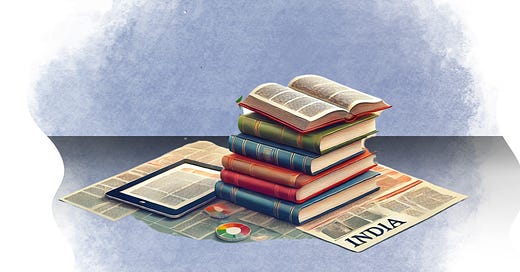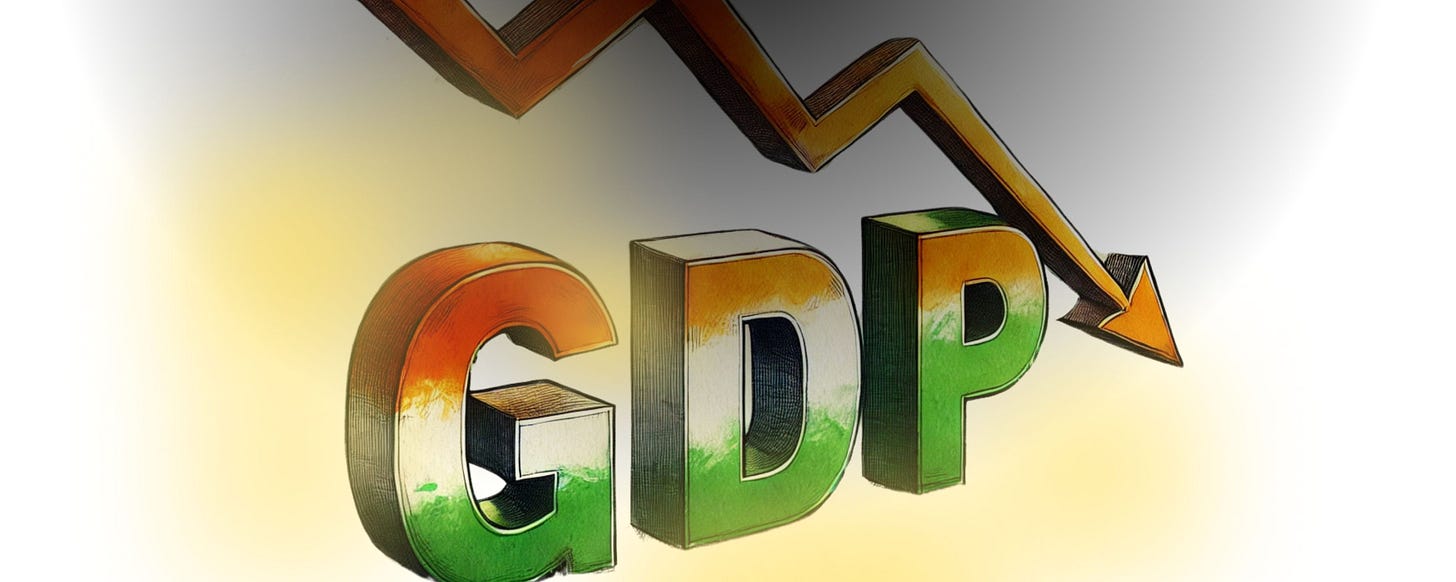#12 Promoting Research with Subscription Access: ONOS, Safeguarding Children from Social Media, Economic Outlook and QR-Enabled PAN
Welcome to the twelfth edition of Policy Mandala. We have structured this edition on a 2-2-1 structure, 2 detailed analyses, 2 recent policy news, and a book recommendation. Enjoy Reading.
Analysis Mandala: Deepening Policy Understanding
Below, we discuss one recent policy update from the past week(s), and analyze them for you: From to! Let’s go!
Analysis #1: Government launches One Nation, One Subscription, or is this just repackaging an Old Scheme
Research is hard! Not just the possibility of creating new knowledge, but also because it requires access to new knowledge: research papers.
Traditionally, researchers pay a fee to access one or more published research papers, and it’s a massive sector of the economy with a worldwide revenue of $19 billion. Most of this revenue comes from universities buying subscriptions to these journals at a hefty pay to ease access from participating universities.
This is now set to change, with the government announcing last week about One Nation, One Subscription (ONOS)—a policy that’s as ambitious as its name suggests. But will it deliver? Let’s dive in.
India is a paradox when it comes to research. We’re the world’s third-most prolific publisher of research papers, yet a shocking number of these gems never get cited. Why? They’re either behind expensive paywalls or don’t make the cut in high-impact journals. Take this stat: 30% of Indian research papers went uncited in 2020, compared to just 20% in the U.S. and China. Meanwhile, Indian universities collectively spend over ₹1,500 crore annually on journal subscriptions. That’s a lot of money for access that’s still far from universal. And then there’s the “gold open-access” model—where researchers pay publishers to make their work freely available. Sounds good? Sure, if you’re a cash-rich researcher (read: not Indian academia). For many, this is just another cost to bear.
The One Nation, One Subscription policy promises to level the playing field by giving centralized access to 13,000 top journals. That’s not just a big number—it’s an all-you-can-read buffet for researchers, students, and scientists alike. With ₹6,000 crore allocated over three years (2025–2027), this initiative will fund subscriptions with 30 leading publishers. Phase 1 alone is set to benefit 6,300 institutions and 1.8 crore students and researchers. The government will handle these costs, saving institutions up to 18% on their library budgets, which can then be directed toward other priorities.
Sounds Exciting, right?
Well, yes and no. Yes, because we are talking about an at-scale project, and no because, we already have INFLIBET doing the same.
The difference here is scale. INFLIBNET’s reach was limited to 4,000 colleges, while ONOS is targeting 6,300 institutions in its first phase and has plans to eventually include more private colleges, Tier 2 and 3 institutions, and standalone research centers. Think of it as INFLIBNET 2.0—but with much bigger ambitions.
ONOS isn’t a standalone policy. It’s part of a larger ecosystem designed to make India a global leader in research and innovation. The NEP 2020 emphasizes integrating research into higher education, while the Anusandhan National Research Foundation (ANRF) is working to seed and promote R&D across universities and labs. Combine this with Digital India’s push to strengthen infrastructure, and the result is a robust backbone for research—provided we overcome systemic challenges.
So, what can ONOS achieve? With access to top journals, Indian researchers can aim for higher-quality, high-impact work, boosting India’s global research footprint. Institutions save money, students and faculty gain better access, and the playing field is leveled for researchers in smaller institutions and Tier 2/3 cities. However, challenges remain. Research Paper Access only partly solves the data equity process, the real process to boost research temperament will probably flow by creating an ecosystem, with ONOS playing a major role.
ONOS isn’t just about access—it’s about creating a culture where knowledge is democratized and innovation thrives. Whether it succeeds or stumbles will depend on execution and whether we address underlying issues like infrastructure and researcher habits. For now, let’s give credit where it’s due: the government is shaking up an outdated system and trying to make research accessible to millions. Whether ONOS will be India’s research revolution or just another acronym remains to be seen.
What do you think? Does ONOS excite you? Concern you? Or is it just another policy in the pipeline? We’d love to hear your thoughts. Drop us a note—we’re all ears!
Analysis #2: Guarding Childhood: The Law Limiting Social Media Access for Minors
Did you know an Indian teenager spends over 4 hours a day on social media? That’s more than double the time they spend with friends in person. With 46 crore Indians on platforms like Facebook and Instagram, social media isn’t just part of our lives—it’s a way of life. From roti-making tutorials to political memes, these platforms dominate our attention spans.
But Australia thinks it’s time to hit the brakes—at least for teenagers.
Australia’s Online Safety Amendment (Social Media Minimum Age) Bill 2024 bans anyone under 16 from using platforms like TikTok and Snapchat. Starting in 2025, Australia’s teens will have to find new ways to entertain themselves: offline, no less. It’s a pioneering step to address mental health concerns and excessive screen time.
Australia isn’t the only country rethinking kids’ digital boundaries. France is testing smartphone bans for kids under 15 in schools, and China has mandatory real-name registration and time limits for minors online. In South Korea, the “Shutdown Law” restricts late-night gaming for minors. The US has also joined the action, with Florida requiring parental consent for social media users under 16.
So, should India follow suit? It’s tempting to imagine our teens spending less time on Instagram and more on, say, books. But in a country where digital platforms are key to education, creativity, and even livelihoods, a blanket ban could backfire. Instead of cutting screen time, it might push kids to unregulated corners of the internet, where the risks are far greater.
Social media’s influence extends beyond kids—it’s also reshaping how nations exert sovereignty. Remember when WhatsApp resisted traceability rules, or Twitter clashed with the government over content regulations? These platforms often act as global entities, sometimes ignoring local laws. Australia’s move isn’t just about protecting kids; it’s about reclaiming control over the digital space.
For India, implementing such a law would be a logistical nightmare. With over 1.4 billion people, diverse tech literacy levels, and our jugaad mindset, enforcing age restrictions would be nearly impossible. Tech-savvy teens can easily fake IDs, and monitoring compliance on this scale is a Herculean task.
This is where civil society must step up. Parents, educators, and communities need to work together to create a pan-India network that champions online safety. Imagine digital literacy programs in schools or parent-teacher associations evolving into watchdogs for safer internet use. A collective approach could protect young minds without cutting them off from opportunities.
So, should we #BanItLikeAustralia?
Maybe not. But we can’t ignore the impact of social media on young people—or the need for a balance that fits our unique challenges. What do you think? Let’s figure it out before our next scroll session. 😉
News Mandala: What, Why, and How of Recent Policy
Below, we discuss two recent policy updates from the past week(s), and present them for you: From India’s GDP Fall to PAN 2.0. Let’s start.
New#1: India’s GDP Growth Slows to 5.4%: Alarm Bells or a Momentary Blip?
India’s GDP growth for Q2 FY2024-25 slowed to 5.4%, the weakest in 18 months, down from 8.1% a year ago and 6.7% in Q1. Falling short of economists’ expectations of 6.5% and the RBI’s 7.2% projection, the data points to broad-based weaknesses across economic segments.
GDP, a key measure of economic growth, is derived from four components: private consumption (C), private investment (I), government expenditure (G), and net exports (Nx).
Private consumption, the largest driver of GDP, grew at just 6%, down from 7.4% in Q1. Urban households, hit by declining corporate wage growth, reduced discretionary spending. Private investment also weakened, with growth slipping to 5.4%, a six-quarter low. Manufacturing growth collapsed to 2.2% (from 14.3% last year), while mining contracted and construction slowed.
Government expenditure was modest, as capital spending was deferred due to the 2024 Lok Sabha elections. Meanwhile, export growth slowed sharply to 2.8%, widening the trade deficit amid high oil prices and global headwinds.
India faces challenges like weakening urban consumption, rural distress, and sluggish private investment amid global uncertainties.
However, signs of recovery, including rising GST collections and festive spending, offer hope. Achieving long-term growth and the $5 trillion economy target requires bold reforms and a manufacturing boost to compete with Southeast Asia. The slowdown underscores the need for systemic resilience, with the coming months critical for shaping India’s economic trajectory.
News #2: QR-Enabled PAN 2.0: Revamping the Tax Landscape
The Cabinet Committee on Economic Affairs (CCEA) has approved the Rs. 1,435 crore PAN 2.0 Project to modernize India's Permanent Account Number (PAN) system. This e-Governance initiative by the Income Tax Department aims to enhance the existing PAN infrastructure, making it more efficient, secure, and accessible for taxpayers.
Introduced in 1972 under the Income Tax Act, the PAN system was a game-changer in combating tax evasion by providing standardized taxpayer identification. However, with evolving technology and India's growing digital landscape, it required an upgrade. PAN 2.0 will introduce QR-coded PAN cards, ensuring faster services, consistent data, and alignment with the Digital India vision. Key features include improved accessibility, eco-friendly processes, cost optimization, and enhanced infrastructure security.
Existing PAN cards will remain valid unless unlinked from Aadhaar. The absence of a QR code will not invalidate them.
Before PAN, India's tax system lacked mechanisms to curb evasion and maintain transparency. With its introduction, compliance improved significantly, expanding the tax base and reducing revenue loss. By the early 2000s, there was a noticeable increase in the number of registered taxpayers in India. A trend that continues as PAN is increasingly integrated into financial and governmental services.
Complementing India’s ongoing tax reforms, PAN 2.0 promises greater digital integration. However, questions remain about whether these advancements will truly address tax evasion on a significant scale. Will this substantial investment bring transformative change, or will it merely create a façade of progress in an increasingly complex digital economy? The answer lies in its implementation.
Book Mandala
In this section, we suggest a book to be read/listened each week, for the inner policy enthusiast in you :)
Book: The Gym of Leadership
Author: Anil Khandelwal
About Book: The Gym of Leadership by Anil Khandelwal reimagines leadership development as a fitness journey. With relatable analogies, it emphasizes building 18 core skills like emotional regulation and communication, vital for navigating today’s volatile and complex world. Aspiring leaders will connect with the book's practical tips, whether honing self-awareness or managing relationships. A transformative guide, it’s designed to equip readers with tools for personal and professional growth.
Our Take: This book felt like a wake-up call for leadership in a rapidly changing world. The author’s own experiences of leadership in transforming the Bank of Baroda as a chairman drive a lot of his leadership lessons. The fitness metaphor makes developing leadership skills seem achievable yet rewarding. It pushed us to rethink leadership as an ongoing commitment, not just a position. A refreshing blend of insight and practicality, let this book inspire you to strengthen your leadership muscles :)
Hope you liked today’s Policy Mandala!
We believe nation-building needs a community of changemakers—so we’re creating Bharat Mandala, an ecosystem for impact. Be part of our journey here!







